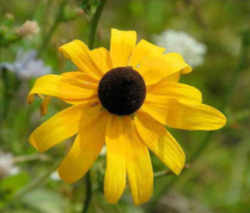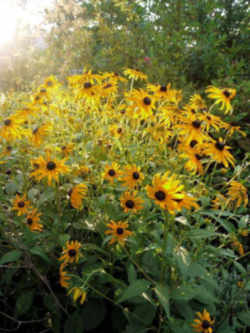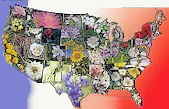Maryland State Flower (Floral Emblem)
Black-eyed Susan

(Rudbeckia hirta)
Adopted on April 18, 1918.
Inspired by the 1893 World's Fair (World's Columbian Exposition) in Chicago was the motivating factor to a group of women at the Maryland Agricultural College in 1896. They thought that Maryland should have an official state flower and they thought it should be the black-eyed Susan.
The Black-eyed Susan, (Rudbeckia hirta,) has been the official Maryland flower since 1918 when it was designated the "Floral Emblem" of Maryland by the General Assembly (Chapter 458, Acts of 1918; Code State Government Article, sec. 13-305)
In his Species Plantarum (1753), the Swedish naturalist Linnaeus described and named the flower Rudbeckia after Olav Rudbeck and his son, both professors at the University of Uppsala, and hirta from the Latin meaning "rough hairy".
Maryland State Flower: Black-Eyed Susan

Rudbeckia hirta, commonly called black-eyed Susan, is a species of flowering plant in the family Asteraceae, native to the central United States. It is one of a number of plants with the common name black-eyed Susan. Other common names for this plant include: brown-eyed Susan, brown Betty, gloriosa daisy, golden Jerusalem, Poorland daisy, yellow daisy, and yellow ox-eye daisy.
Black-eyed susan is a rough, hairy perennial daisies or coneflowers, members of the sunflower family (Asteraceae). The flower's yellow rays circle a dark-brown, spherical center measuring 2 to 3 inches in diameter. Commonly found in fields and on roadsides, they bloom between May and August, reaching 2 to 3 feet in height. They are native to the United States, east of the Rocky Mountains.
Identification of the Black-eyed Susan
- Height: Plants are up to two feet tall, with narrow, toothed leaves that .
- Leaves: Spaced alternately on the stem, mostly basal with coarse hairs.
- Flower: Biennial that flowers at the end of the second growing season. Heads are about two inches across. The short disc flowers in the center of the head are dark purplish-black, whereas the long outside ray flowers are bright yellow.
- Fruit: Smooth, four-angled achenes.
- Habitat: The Black-eyed Susan is a biennial that thrives in the high temps and direct sunlight. It is usually found in the meadows and pastures, as well as old fields and roadsides. They usually grow in undisturbed habitats and, even flourished in the Western Prairies in the early to mid 1900's. They however, are not as common as they were. The R. hirta. can also survive very well under cultivation and if cared for properly can flower a third year. Although they are found in Canada, they are not prevalent in many areas, such as Nova Scotia.
The Maryland Statutes
The law designating the black-eyed susan as the official Maryland state flower is found in the Maryland Statutes, Title 13, Section 13-305.
TITLE 13. STATE GOVERNMENT.
SECTION 13-305.
§ 13-305.
The black-eyed susan (Rudbeckia hirta) is the State flower.
Taxonomic Hierarchy: Black-eyed Susan
Kingdom: Plantae - Plants
Subkingdom: Tracheobionta - Vascular plants
Superdivision: Spermatophyta - Seed plants
Division: Magnoliophyta - Flowering plants
Class: Magnoliopsida - Dicotyledons
Subclass: Asteridae
Order: Asterales
Family: Asteraceae - Aster family
Genus: Rudbeckia L. - coneflower
Species: Rudbeckia hirta L. - blackeyed Susan
State Floral Emblems








